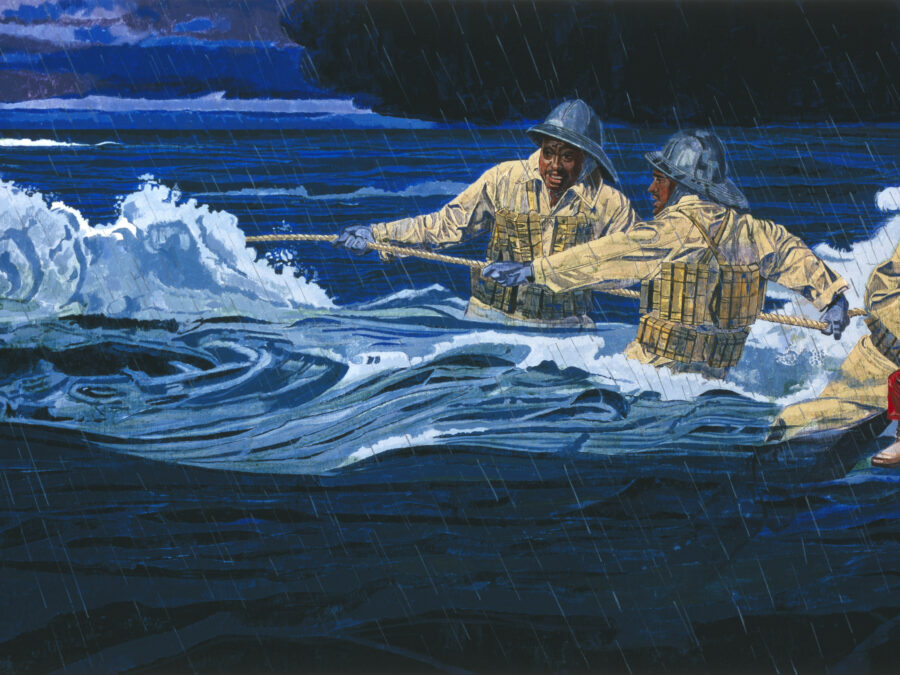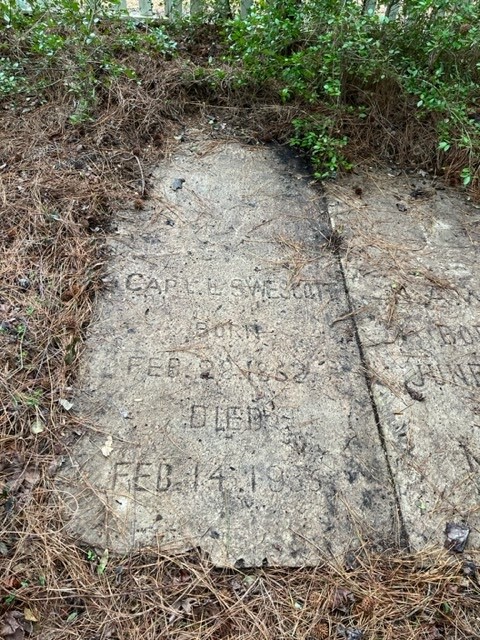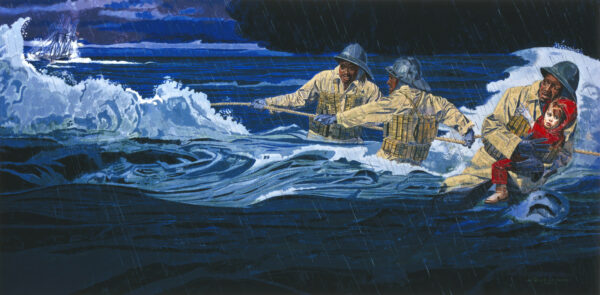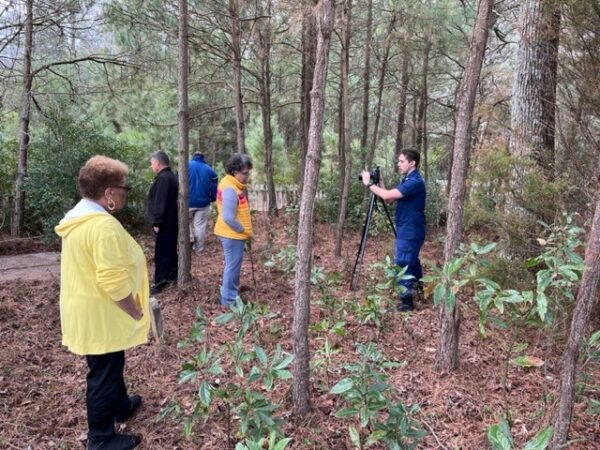
Creeping vines and underbrush slowly crawl to cover a light-gray stone slab, attempting to conceal the grave’s resident from the eyes of the world, a Jarvisburg, North Carolina, local legend’s final resting place—hidden from the world for more than half a century—nearly lost to history, until that all changed near the end of 2022.
A surreal gray-white dust cloud rises from the long gravel road as a vehicle makes its way down to a two-story sea-green house with an overhang porch. Along the driveway to the right sits a waist-high white picket fence around a small grove of trees. As the car pulls to stop and its occupants step out, they take in the sight of their new home.
After walking through the house, the homeowner, Gavin Wente steps onto his back porch, to check out the view of his backyard. Off to his left is a small pond with an island at its center. In the opposite direction he spots another peculiar grove of trees with a similar picket fence surrounding it.
Ensnared by curiosity, Wente walks over to this picketed area. As he gets closer and opens the small gate, he notices what looks to be small white, weather-stained standing stones covered by creeping vines and brush. His interest piqued, he explores farther into the little grove to discover more stones, but these stones have etchings on them.

Wente had just discovered one of the little cemeteries on his newly acquired property, which the previous owner had informed him about.
During Thanksgiving, Wente’s son and daughter decided to help their father clear out some of the brush from the grove and made a discovery that would uncover the whereabouts of a Pea Island Keeper, one whose last resting place was lost for more than 70 years.
“My daughter had texted me ‘there is a name on one of these stones,’” said Wente, reliving the discovery.
On the slate of stone was etched the name and dates, “Capt. L.S. Wescott Feb. 28, 1852 – Feb. 14, 1935.”
“She asked me if the name meant anything to me,” said Wente. “In my 30-years of service in the Coast Guard, knowing the service’s history and legacy, as well as my location here in Jarvisburg, I had an idea of the keepers of Station Pea Island.”
Wescott was one of the original members of the Pea Island Life-Saving Service Station along the Outer Banks of North Carolina during the late 1800s. He was also one of the station’s keepers, a person who was in charge of the station.

Upon this discovery, Wente knew he had found something significant and reached out to multiple people he knew, one being the Coast Guard Atlantic Area Historian, Dr. William Thiessen, and members of the Pea Island Preservation Society, who shed light on the legacy of Wescott and the Pea Island crew.
On Oct. 4, 1900, Lewis S. Wescott became Keeper Wescott of Pea Island Life-Saving Station. In 1915, the Life-Saving Service and Revenue Cutter Service merged to form today’s Coast Guard. With this merger of those services, Wescott, being the current Keeper of Life-Saving Station Pea Island, would have become the first Black officer-in-charge of a U.S. Coast Guard Station.
“Capt. Lewis S. Wescott received the title due to his respected position as head of the Pea Island Station,” said Thiesen.
Thiesen added, “He served as officer-in-charge of the station for 16 years, second only to famed keeper, Richard Etheridge’s 20 years as the station’s keeper. Wescott was a member of the original all-Black crew established in 1880 and he served the arduous lifesaving duty continuously for 36 years.”
Before taking command of Pea Island in 1900, Wescott learned and served under Etheridge, who would drill his crew meticulously, which would become an invaluable aspect for those men. This training would also help Wescott when he became a keeper.
To get an idea of the legacy left by Wescott and his fellow surfmen from Station Pea Island take a moment to imagine yourself witnessing the bravery of the Pea Island crew in the midst of a savage storm.
In October 1896, howling hurricane winds blasted the three-masted schooner, E.S Newman, nearly 100 miles off course and slamming the ship aground about two miles south of the Pea Island Station.
Due to the storm’s severity, Etheridge, the Pea Island Station Keeper, suspended the routine beach patrols that his crew would diligently do on a regular basis. However, that didn’t mean he and his crew didn’t keep a watch for any vessels in distress or needing assistance.
This would be the Newman crew’s saving grace—that and Etheridge’s rigorous training for his crew—that would ensure the ship’s crew would escape the fury of the howling winds and angry sea. The sea and winds had heaved the ship off course, but the vigilant eyes of a watchman noticed a distress signal.
Theodore Meekins, a surfman at Station Pea Island, saw the distress flare and notified Etheridge. He and his crew immediately set their training into motion. They launched their surfboat.
Etheridge and his crew battled against the raging seas, that at this point created strong tides and sweeping currents, yet this crew looked into the face of the raging waves in defiance.
Seeing the fierceness of the sea, Etheridge knew he needed to change tactics. He used a long tethering line and sent his two strongest swimmers into the raging seas toward the ravaged boat and the nine souls aboard. The sea roared and raged, not wanting to give up its prey. However, these surfmen wouldn’t let the sea have its prize and made it to the schooner. These men didn’t do this just once, they did this 10 times. Each time these brave and strong surfmen brought one of the souls aboard the Newman ashore to safety from the furious sea.

Nearly 100 years to the day after the rescue, Etheridge and his crew were posthumously awarded the Gold Lifesaving Medal. One of those men part of that rescue was Wescott.

The leadership that Wescott learned from Etheridge would serve him eight years later when he became the keeper of Pea Island Lifesaving Station.
A little before midnight on Dec. 11, 1904, a substantially strong north-northwest gale, mixed with a snowstorm and rough seas unleashed its fury on the seven-man crew of the three-masted schooner, Montana, which was ladened with salt. The storm and seas once again teamed up to shove this vessel along the coast with the goal of tearing it to pieces.
Fortunately for the Montana crew, the storm beached the vessel about a quarter mile north of Station Pea Island, with Wescott as the keeper. Wescott and his crew worked tirelessly until morning on rescue attempts, that seemed to keep failing.
After battling the raging frigid waters, the surfmen under Wescott’s leadership were able to rescue six of the seven men.
Wescott would go on to lead his crew to other rescues along the Outer Banks of North Carolina before retiring on his birthday after more than 30 years of service. He retired officially from being the keeper of Coast Guard Station Pea Island on Feb. 28, 1916, at the age of 64.
Nearly 19 years to the day of Wescott’s retirement, he passed away and would be buried in Jarvisburg, North Carolina in 1935 in that little grove where trees and brush grow. Instead of the location of his grave being lost to history and nature’s creeping vines, it was rediscovered by Wente, who served in the very service Wescott retired from.
The unearthing of Wescott’s resting place had a profound impact on people of the Jarvisburg. William Jarvis, a retired Air Force senior master sergeant and Jarvisburg native mentioned he and many others in the local Jarvisburg area were excited and humbled at this discovery, because of what men like Wescott and the other Station Pea Island members meant to their community.

“As a kid, I heard my dad always speak of the Wescott brothers,” said Jarvis. “This is another piece of history for Black America.”
Jarvis also mentioned he and others grew up hearing stories of the Pea Island crew and the heroic actions those men accomplished during their time serving as surfmen at the Life-Saving Station.
Wescott’s legacy, along with those of his fellow servicemembers of the Pea Island Life-Saving Service Station have left a lasting impact of devotion to duty, which is seen through the Pea Island crew’s actions time and time again. These men had an impact beyond just the service they were a part of but also the communities they lived with.
Like a mountain’s shadow stretching across a valley, the legacy Wescott left behind has had a lasting impact on more people than he could ever imagine.
National Coast Guard Museum insider tip:
The story of Black Coast Guardsmen will be woven throughout the museum, but the Pea Island narrative, specifically, will be located on Deck 2 as part of the story of the U.S. Life Saving Service.
